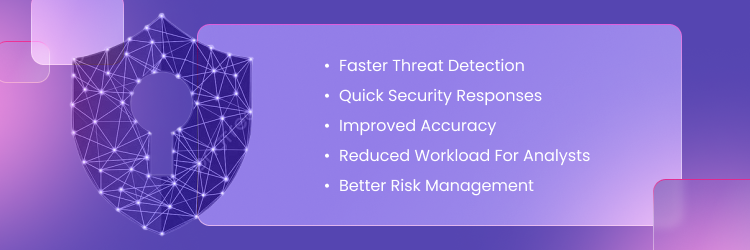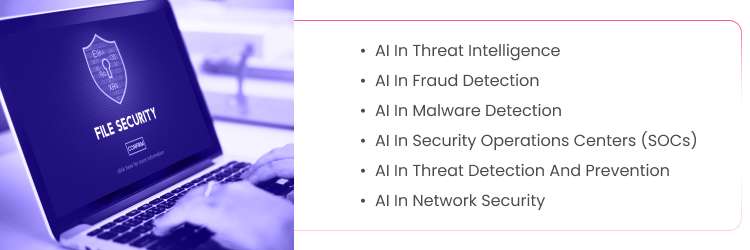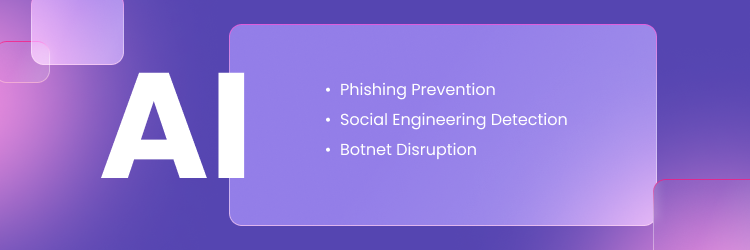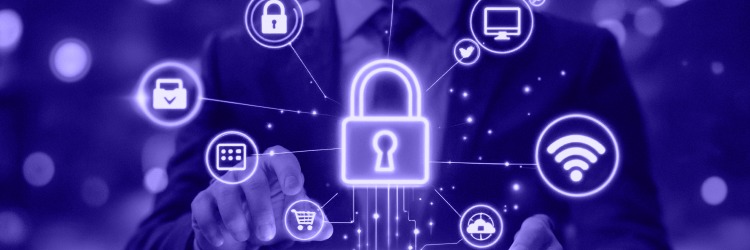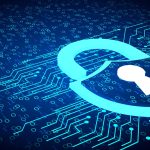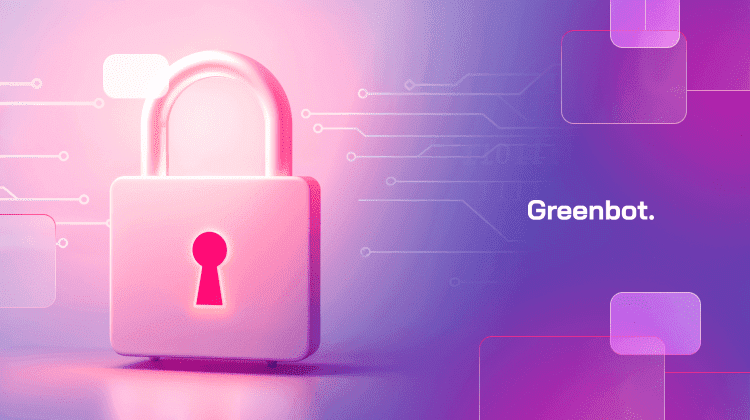
AI cybersecurity is transforming digital defense. Artificial intelligence helps security teams prevent cyber threats by identifying risks faster and automating responses. AI reduces human workload, improves accuracy, and strengthens security strategies. It is changing how organizations protect data, detect attacks, and respond to incidents.
In this guide, we’ll explore how AI shapes cybersecurity.
What is AI in Cybersecurity?
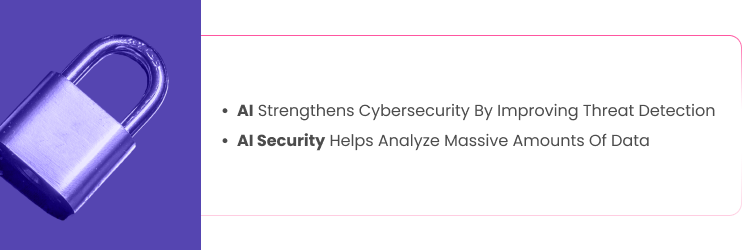
Artificial intelligence (AI) strengthens cybersecurity by improving threat detection and automating security defenses. AI security helps analyze massive amounts of data to uncover behavior patterns linked to attacks.
It relies on advanced AI algorithms like machine learning (ML) and deep learning (DL). These technologies process security data, detect unknown threats, and enhance data protection.
AI-powered entity behavior analytics monitors activity across networks, spotting unusual access or suspicious changes. This allows security professionals to act faster against cyber risks.
How Does AI for Cybersecurity Work?
AI performs tasks that traditional methods cannot handle efficiently. It scans systems in real-time, recognizing patterns of cyber threats before they cause harm.
Machine learning models improve vulnerability management by detecting weaknesses and predicting potential breaches. AI quickly flags security incidents, stopping threats before they spread.
AI also helps in isolating affected systems, minimizing damage during attacks. It also enhances threat hunting, helping analysts track risks faster.
To ensure safety, companies must focus on responsible AI. Balancing automation with human intelligence keeps data privacy secure while strengthening defenses.
Benefits of AI in Cybersecurity
AI improves cybersecurity operations by enhancing speed, accuracy, and automation. Its key benefits include:
- Faster threat detection: AI analyzes massive amounts of data in real-time, identifying risks instantly.
- Quick security responses: AI quickly isolates affected systems, reducing attack damage.
- Improved accuracy: AI-powered entity behavior analytics detects unknown threats with fewer false alarms.
- Reduced workload for analysts: AI performs tasks that used to require manual tasks, allowing security professionals to focus on critical risks.
- Better risk management: AI helps in identifying vulnerabilities and strengthens data protection with predictive analysis.
Key Use Cases of AI in Cybersecurity
AI in Threat Intelligence
AI analyzes security data from network logs, threat feeds, and the dark web. It detects cyber attacks early and warns teams of risks. Cybersecurity machine learning helps tools like IBM Watson for Cyber Security predict threats before they escalate.
AI in Fraud Detection
Banks and financial institutions use AI to spot fraud in real time. Machine learning algorithms flag suspicious transactions while reducing false alarms. HSBC improved fraud detection by using AI to track unusual user behavior, cutting fraud-related losses.
AI in Malware Detection
AI enhances security solutions by detecting new and unknown malware. Systems like CrowdStrike Falcon and Microsoft Defender use cybersecurity machine learning to block future attacks, including zero-day threats and ransomware.
AI in Security Operations Centers (SOCs)
AI helps security analysts by automating responses and reducing manual work. Tools like Splunk and Cortex XSOAR prioritize alerts, allowing teams to focus on critical threats. One company using AI in its SOC cut incident response times by 50%, making defenses more efficient.
AI in Threat Detection and Prevention
AI recognizes patterns in cyber threats before they cause harm. It scans massive amounts of data, detecting unknown threats by analyzing system behavior.
Advanced AI algorithms predict attacks by identifying warning signs linked to malware or phishing. AI-driven threat hunting helps security professionals find hidden risks early.
Large Language Models (LLMs) also help security systems improve phishing detection and anomaly identification.
AI in Network Security
AI spots security incidents, such as unknown threats or unauthorized access, before they spread.
AI-powered entity behavior analytics tracks users and devices, flagging suspicious activity. It helps security professionals isolate affected systems to stop intrusions.
Unlike traditional methods, AI adapts to evolving threats, making security operations more proactive. It also ensures data privacy, preventing unauthorized data access.
Using AI for Cyber Risk Assessment
AI helps businesses understand their security risks by analyzing data from network traffic, past attacks, and system vulnerabilities. It identifies weak points and ranks them based on how likely they are to be exploited.
Machine learning improves risk scoring by predicting which threats are most dangerous. This helps security teams focus on fixing the most urgent issues first.
AI also tracks patterns from past breaches to detect emerging threats. It suggests preventive actions like updating software, tightening access controls, or blocking suspicious activity.
By using AI, businesses can reduce risks before an attack happens and make security decisions based on real-time data.
AI vs. Traditional Cybersecurity Methods
Here is a comparison of AI security and traditional cybersecurity methods:
| Feature | Traditional Security | AI-Driven Security |
| Cost Efficiency | High labor costs: Requires large teams for monitoring and analysis. | Lower long-term costs: Reduces manual workloads and optimizes resource allocation. |
| Scalability | Limited: Limited by static configurations and human resources, which may struggle to adapt to rapidly growing data volumes and evolving cyber threats. | Highly scalable: Processes petabytes of data across cloud, IoT, and hybrid networks. |
| Detection Speed | Slower: Relies on signature-based detection (predefined rules) and manual analysis. | Faster: Uses behavioral analysis and real-time data processing to detect threats instantly. |
| Accuracy | Higher false positives: Static rules flag benign activities as suspicious. | More precise: Employs advanced pattern recognition and continuous learning, reducing false alarms and enhancing the precision of threat identification. |
| Response Time | Manual intervention needed: Human intervention is required for threat analysis and mitigation, leading to slower responses. | Automated response: AI isolates threats (e.g., blocking IPs, quarantining files) in seconds. |
Challenges and Risks of AI in Cybersecurity
AI makes cybersecurity stronger, but it also comes with risks. Here are some major challenges:
- AI-powered attacks: Hackers use AI to create advanced malware and fake phishing emails that bypass detection.
- Bias in AI models: If AI is trained on biased data, it may overlook threats or make unfair security decisions.
- High costs: AI needs expensive tools, expert talent, and regular updates, making it hard for small businesses to adopt.
- Privacy risks: AI collects and processes large amounts of data, raising concerns about user privacy and compliance with laws like GDPR.
- Over-reliance on automation: AI can’t replace human judgment. Relying too much on AI may leave gaps in security when facing new, unpredictable threats.
AI-Powered Cybersecurity Tools and Solutions
AI tools help businesses detect and stop cyber threats faster. They scan large amounts of security data, flag risks, and take action automatically.
Popular AI cybersecurity tools include:
- IBM Watson for Cyber Security. Helps detect threats by analyzing vast amounts of security data.
- Microsoft Defender. Uses AI to stop malware, phishing, and other online attacks.
- Darktrace. Identifies unusual behavior in networks to catch cyber threats early.
Companies can improve security by combining AI-driven tools with traditional defenses. AI also enhances incident response, making security teams more efficient.
In the future, AI will play a bigger role in stopping ransomware. It can detect suspicious file activity and isolate infected systems before an attack spreads.
The Role of AI in Combating Cybercrime
AI helps fight phishing, fraud, and botnets by identifying suspicious activity and blocking attacks.
- Phishing prevention. AI scans emails and websites for scams, protecting users from fake links and messages.
- Social engineering detection. AI analyzes communication patterns to spot manipulation tactics used in cyber scams.
- Botnet disruption. AI tracks botnet activity and shuts down hacker-controlled networks before they cause harm.
AI makes cybercrime harder, but hackers are also using AI to create smarter attacks. Security teams must stay ahead by improving AI defenses.
Impact of Generative AI in Cybersecurity
Generative AI is changing cybersecurity by creating attack simulations. Security teams use it to test defenses against fake phishing emails, deepfakes, and malware variants. This helps organizations prepare for evolving threats.
However, Generative AI also introduces risks. Hackers can create highly convincing phishing scams and social engineering attacks. They can also develop undetectable malware, making cyberattacks harder to stop.
To counter these threats, security teams are using Generative AI for training detection systems. It helps identify AI-generated cyberattacks and improve defense strategies. The future of cybersecurity will depend on balancing these benefits and risks.
Ethical Considerations and AI Governance in Cybersecurity
AI ethics in cybersecurity must be transparent and fair. When AI makes security decisions, people should understand why. Black-box AI can block users or flag threats without explanation, leading to unfair outcomes.
To solve this, experts use explainable AI frameworks like LIME and SHAP. These tools break down AI decisions, making them clear and easy to audit. This improves trust, accountability, and compliance.
Governments are also stepping in with new AI regulations. Laws like the EU AI Act and NIST guidelines set rules for ethical AI use. Companies must follow strict risk assessments and ensure human oversight in AI-driven security.
Future of AI in Cybersecurity
AI is becoming smarter, faster, and more independent in stopping cyber threats. Autonomous AI systems will predict attacks and block them in real-time, reducing human workload.
New technologies like quantum computing will help AI break sophisticated cyberattacks such as polymorphic malware. AI-driven SOAR platforms will handle threats automatically, making security teams more efficient.
AI threat intelligence will improve by analyzing dark web activity and tracking attack patterns worldwide. Federated learning will allow companies to share threat data without exposing sensitive information.
Tools like MITRE CALDERA already simulate AI-driven cyberattacks to test defenses. Over the next decade, AI will play a bigger role in stopping deepfakes, AI-powered hacks, and social engineering attacks.
Governments will create regulatory sandboxes to test AI security tools safely. By 2033, AI will likely cut breach response times by 90%, making cybersecurity stronger and more proactive.
FAQs About AI Cybersecurity
How will artificial intelligence affect cybersecurity?
Artificial intelligence makes security operations faster and smarter. But it also creates risks, like AI-powered attacks and privacy concerns.
What are examples of AI in cybersecurity?
AI helps in threat hunting, vulnerability management, and security incidents. It powers advanced AI algorithms in machine learning-based tools like entity behavior analytics and automated security decision-making.
What are the threats to AI security?
Hackers can manipulate artificial intelligence models, causing errors in identifying vulnerabilities. Other risks include data privacy breaches, AI-generated phishing attacks, and over-reliance on automation instead of human intelligence.
AI Cybersecurity: Our Final Thoughts
AI cybersecurity is transforming digital security by enhancing threat detection, automating responses, and improving risk management. By analyzing vast amounts of data in real time, AI helps organizations identify vulnerabilities, prevent attacks, and strengthen defenses more efficiently.
However, AI also introduces new challenges, such as AI-powered cyber threats and privacy concerns. To maximize its benefits, companies must balance automation with human oversight, ensuring ethical and responsible AI implementation while staying ahead of evolving cyber risks.


